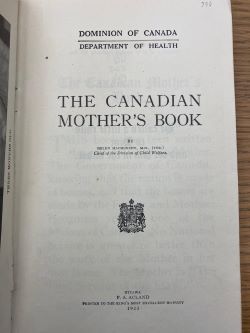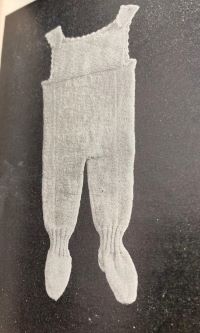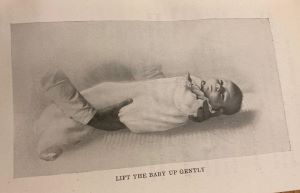
When Ernest and Hadley arrived in Canada in 1923, just weeks before the birth of their first child, the Department of Health1 gave them a free copy of The Canadian Mother’s Book. A little over a hundred years later I went to the Library and Archives Canada in Ottawa to see this book for myself.
From the title leaf I learned it had been written by “Helen MacMurchy, M.D.” On looking her up, I discovered she had earned a medical degree in 1901, and her post-graduate work and studies of childbirth in Canada had revealed nationwide high infant mortality rates. MacMurchy determined to be part of reversing this alarming trend, and in 1920 became director of the “Division of Child Welfare” in the federal government’s new Department of Health. Her Canadian Mother’s Book series2 was designed to help prospective mothers deliver and raise healthy babies, with advice covering the period from the time when the pregnancy was first known right through the baby’s toddlerhood.

Early on the book exhibits a level of feminist activism I had not expected from a 1920s text. It begins by encouraging the expectant mother to survey her neighbors about area doctors and to be particular about choosing a doctor who has not lost mothers and who is reputed to be clean (10). On reading more about the background of The Canadian Mother’s Book, I learned MacMurchy had been an early advocate for the idea of state-funded “mothers’ pensions” that would permit working mothers to stay home and nurse and care for their infants.3 This was an astoundingly progressive suggestion for that time. Ultimately, fifteen weeks of paid maternity leave was implemented by Canada's federal government (as enabled via the unemployment insurance program), but that wasn’t until 1971.4
MacMurchy also encourages the book’s female reader to extend her network of support to include the husband, who should be ready to do things like prepare dry toast and tea for the expectant mother in the event of morning sickness. At some point Ernest has to have encountered this book—either by reading it himself or (as I imagine is more likely) by Hadley reading it out loud to him—because this is exactly the type of material he later mocked in a letter to Gertrude Stein. As Ernest was well-aware, his joke in a letter to Stein about telling the Canadian mother to get out of bed5 ran directly counter to the actual advice given in The Canadian Mothers’ Book, which stressed the supportive role that should be played by soon-to-be fathers, observing for example, “Your husband will do one or two easy exercises with you” (20).

As I looked through the little blue book at the National Archives with which Hadley and Ernest had once been familiar, I could not help but be amused by some of the book’s earnestness, arguably still a trait with which others associate our nation. While the book’s author stressed that expectant mothers should not do anything too strenuous, it also argued that the mother should continue throughout her pregnancy to do light housework since “Most of us Canadians do our own housework” (20). Women were also encouraged to bathe regularly, using full and sponge baths. It was a section that made me smile with its addition, “Of course you are as particular about your toilet as the beaver. He is a model for us Canadians in this respect” (22). Similarly, although I certainly appreciated the advice to expectant mothers to take things easy, I had to chuckle at the book’s statement, “You are to be a Canadian Mother. Rest and be thankful” (28).
I can imagine Hadley reading that passage to Ernest, and both of them laughing. I wonder, though, if such proclamations also struck Hadley as hard. The book repeatedly stresses the nationalism of its title. It was intended for Canadian mothers and addresses the reader—using an inclusive “you”—as a member of a well-defined group. But Hadley was not Canadian. She was an outsider who went through the final weeks of her pregnancy and the early months of baby John’s life in a kind of double exile.
In her Toronto life, Hadley was no longer in the St. Louis of her birth, nor in the city of Paris, where she and Ernest had been happily surrounded by a vibrant community of expatriate artists. Such nationalistic passages in The Canadian Mother’s Book might, therefore, have simultaneously amused Hadley and made her somewhat sad. Ernest’s work as a staff reporter for the Toronto Star often took him out of the city and, even when he was there, his long hours meant that Hadley’s time in Canada consisted mainly of her staying in their apartment without him. That was the context in which she was introduced to this little patriotic book, which may have underscored for her the irony that she read this advice for Canadian mothers as an American reader – in a country where she did not, in any real sense, feel at home.
Works Cited
Comacchio, Cynthia R. Nations are Built of Babies: Saving Ontario's Mothers and Children, (Montreal: McGill-Queen's University Press, 1993).
Hemingway, Ernest. Letter to Gertrude Stein and Alice B. Toklas, 9 November 1923 and [c. mid-December 1923], The Letters of Ernest Hemingway 1923-1925. Volume 2, Edited by Sandra Spanier, Albert J. Defazio, and Robert W. Trogdon (Cambridge: Cambridge UP, 2013).
MacMurchy, Helen. The Canadian Mother’s Book. Dominion of Canada Department of Health (Ottawa: F. A. Acland, 1923). [See this link for a full text scan of the 1921 edition: https://babel.hathitrust.org/cgi/pt?id=ien.35558005446493&seq=5]
“Maternity & parental benefits,” Canadian Labour Congress, https://canadianlabour.ca/who-we-are/history/maternity-parental-benefits/
1 Canada's Department of Health was established in 1919. The department sought to influence public health, create standards for food and drugs, promote child welfare and education, and address high mortality rates among mothers and infants.
2 Because of the book's blue cover, The Canadian Mother's Book quickly became known as "The Little Blue Book." The nickname stuck, and when companion booklets were published, such as MacMurchy's How to Take Care of The Baby, they were printed as part of "The Little Blue Books Mother's Series."
3 Comacchio, Cynthia R. Nations are Built of Babies: Saving Ontario's Mothers and Children, (Montreal: McGill-Queen's University Press, 1993), 83.
4 “Maternity & parental benefits, We Are History,” Canadian Labour Congress, https://canadianlabour.ca/who-we-are/history/maternity-parental-benefits/
5 Ernest Hemingway, letter to Gertrude Stein and Alice B. Toklas, 9 November 1923 and [c. mid-December 1923], The Letters of Ernest Hemingway 1923-1925. Volume 2, Edited by Sandra Spanier, Albert J. Defazio, and Robert W. Trogdon (Cambridge: Cambridge UP, 2013), 90.
Sharon Hamilton is a member of the Hemingway Society Board. She has blogged previously for the Hemingway Society about Hemingway and Hadley’s Chicago Apartment, Hemingway’s New Orleans, and the baseball ticket stub the author took with him to the front in World War I. In October 2023, she presented a webinar on "Hemingway in Toronto" to members of the Hemingway Society.